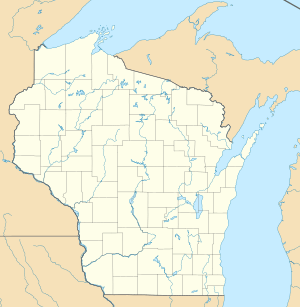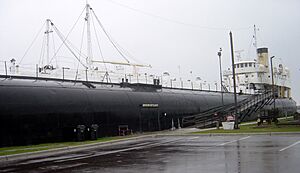SS Meteor (1896) facts for kids

SS Meteor, the only remaining intact "whaleback", Superior, Wisconsin
|
|
Quick facts for kids History |
|
|---|---|
| Name | Frank Rockefeller (1896–1927) |
| Cost | $181,573.38 |
| Launched | 26 April 1896 |
| In service | 1896-1969 |
| Out of service | 1969 |
| Renamed |
|
| Status | Museum ship |
| General characteristics | |
| Length | 380 ft (120 m) |
| Beam | 45 ft (14 m) |
| Depth | 26 ft (7.9 m) |
|
Meteor (Whaleback carrier)
|
|
| Location | Superior, WI |
| Built | 1896 |
| Architect | American Steel Barge Company; McDougall, Alexander |
| Architectural style | Whaleback Lake Freighter |
| NRHP reference No. | 74000081 100002377 (decrease) |
| Significant dates | |
| Added to NRHP | 9 September 1974 |
| Boundary decrease | 26 April 2018 |
The SS Meteor is a very special ship. It's the only one left of a unique design called "whaleback" ships. These ships were created by a Scottish captain named Alexander McDougall. His design helped ships carry a lot of cargo even in shallow water. The Meteor was built in 1896 in Superior, Wisconsin, USA. It sailed for many years, until 1969, with some changes along the way. Today, it's a museum ship in the same city where it was built.
Contents
History of the SS Meteor
Building a Whaleback Ship
The Meteor was built in the summer of 1896. It was constructed by the American Steel Barge Company (ASB) in Superior, Wisconsin. Its original name was Frank Rockefeller. This ship was the 36th of 44 whaleback ships built between 1888 and 1898. Building the Frank Rockefeller cost about $181,573.
Early Years as a Cargo Ship
The Frank Rockefeller joined the ASB fleet. It helped move iron ore from ports on Lake Superior. This ore went to steel mills on Lake Erie. The ship also carried coal back up the lakes. Sometimes, it even carried grain. As a steamer, it often pulled other barges.
In 1900, the ASB fleet was sold. The Frank Rockefeller then became part of the Bessemer Steamship Company. A year later, it changed hands again. It joined the huge Pittsburgh Steamship Company. This company was part of US Steel.
Shipwrecks and New Jobs
On November 2, 1905, the ship ran aground near Isle Royale. It got lost in a snowstorm. Most of the damage came from a barge it was towing. The barge crashed into the Frank Rockefeller's back. The ship was repaired and put back into service. It sailed until 1927.
That year, it was sold and became a sand dredge. Its new name was South Park. As a dredge, it helped get sand for the Chicago World's Fair in 1933. In 1936, it changed jobs again. It became a carrier for cars. It hauled new cars from cities like Detroit and Milwaukee.
Becoming the Meteor
In 1942, the ship was wrecked near Manistique. Normally, it might have been scrapped. But World War II created a big need for ships. So, it was sold to the Cleveland Tanker Company. They changed it into a tanker. This is when it got its current name, Meteor. The Cleveland Tanker Company named their ships after things in space. As a tanker, the Meteor carried gasoline and other liquids for over 25 years.
The Last Whaleback
By 1969, the Meteor was the last of the original whaleback ships. That year, it ran aground again. This happened off Marquette, Michigan. The Cleveland Tanker Company decided not to fix the 73-year-old ship. This was because it was a single-hull tanker and had serious damage.
Since the Meteor was the very last whaleback, it was saved. It was bought, repaired, and moved to Superior, Wisconsin in 1971. There, it became a museum ship. It is still located at Barkers Island today.
The Meteor is the only complete example of these special ships. Other whalebacks are now just wrecks, like the Thomas Wilson. Around 2000, the Meteor needed a lot of work. Its hull was rusting, and the inside needed repairs. In 2004, it was named one of Wisconsin's most endangered historical places. By 2016, much of the ship had been restored and looked great.
What is a Whaleback Ship?
The Meteor is 380 feet long. It is 45 feet wide and 26 feet deep. It was designed to carry a lot of cargo. It has 12 cargo bays. Today, these bays have exhibits about the ship's history.
Whaleback ships, like the Meteor, were unique. They had all their crew and officer living areas at the back of the ship. Only a small room for the anchor was at the front. The Meteor's living areas included rooms for the crew, a kitchen, dining areas, showers, and laundry spots.
Keeping the Meteor Safe
Preservation Efforts
In 2001, several groups started a project. These included the Great Lakes Shipwreck Preservation Society (GLSPS) and the Superior Public Museums (SPM). They called it the S.S. Meteor Preservation and Stabilization Project.
How Volunteers Help
Every April, volunteers gather to work on the Meteor. They help keep the ship in good condition. In 2015, 40 volunteers worked on tasks. They painted parts of the ship and cleaned the exhibit areas. These efforts help make sure the Meteor can be enjoyed by visitors for many years.





